Posted by Candice Johns, Mon, Feb 15, 2016; updated Mon, Mar 18, 2024
There are few things as adorable as a bottle baby...a bottle baby calf, that is.
In this guide we'll dive into what exactly a bottle calf is, what separates this beauties from the herd and how you can hand-feed a calf into greatness!
What is a Bottle Calf?
It is hard to find a cow as sweet, affectionate and people loving as a former bottle calf. The little critters are hand-raised, loved and sometimes feel more like the family dog than the family Heffer. If they weren’t so big and bouncy, I’m pretty sure they would be lounging in living rooms everywhere.
A bottle calf is essentially a young calf that is fed and nurtured using a bottle rather than nursing directly from its mother. This could be due to various circumstances that render the calf an orphan or otherwise separated from its mother.
Reasons Why a Bottle Calf May Have Been Orphaned
These adorable little guys and gals have somehow ended up as orphans. Here are some common reasons why:
Some have lost their mommies
Some have ended up at a sale barn
Some have been separated from mama so the dairy can have the milk
There are calves everywhere looking for good homes. If you find yourself face-to-face with an orphan calf, you may want to say, “YES!” to the little fellow.

Bottle Calf Character Profile
Characteristics that define bottle calves include sweet disposition, endless curiosity and friendliness towards humans. Their comfort with humans can be attributed to their reliance on humans for feeding. Bottle calves often have a docile and affectionate nature due to close human interaction.
Unlike their pasture-fed counterparts, bottle calves often develop distinct personalities that are more akin to household pets, showcasing traits such as increased friendliness, curiosity, and a strong bond with their caregivers.
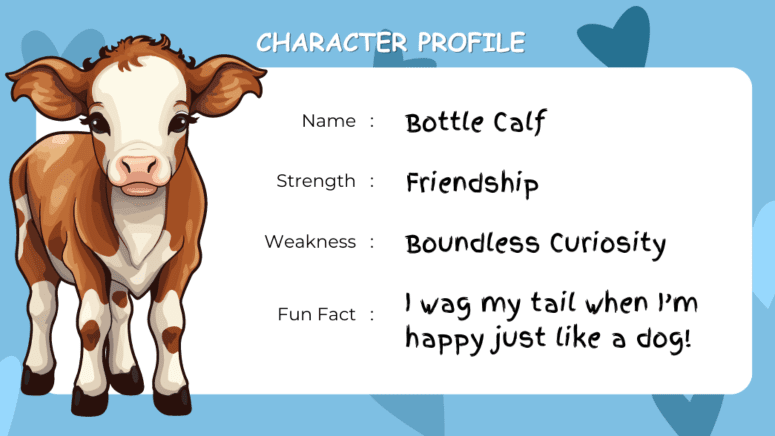
Emotional and Health Benefits of Raising Bottle Calves:
- Enhanced Bonding. The hands-on care required in raising bottle calves fosters a deep emotional connection between the calves and their caregivers. This bond is akin to that of a pet and its owner, filled with affection and mutual trust.
- Therapeutic Interaction. The process of caring for and interacting with bottle calves can be immensely therapeutic. Their playful antics and affectionate natures provide joy and stress relief, making them a source of constant delight for their human companions.
- Sense of Fulfillment. Raising a bottle calf to health and maturity offers a profound sense of accomplishment. Watching a once vulnerable calf grow into a thriving cow or bull under one's care is rewarding and instills a deep sense of pride.
- Controlled Nutrition. Bottle feeding allows for precise control over the calf's nutrition, helping calves to receive the essential vitamins and minerals needed for healthy development.
- Early Detection of Health Issues. The close interaction required in bottle feeding means health issues can be spotted and addressed early, leading to better outcomes for potentially serious conditions.
-
Socialization. Bottle calves often exhibit enhanced social skills due to their frequent interactions with humans and, at times, other animals.
Why You Should Consider a Bottle Calf:
- Bottle feeding is a great way to start your own herd
- It is an excellent way to obtain your own non-GMO, organic, pastured beef (on the cheap)
- Bottle calves will not only become future milk and beef cows, they will also be your companions and friends
- Bottle babies will give you joy and love every day
- You won’t believe how quickly they grow; before you know it, you’ll be calling the A-I (Artificial Insemination) technician for breeding or sending them off to become hamburgers
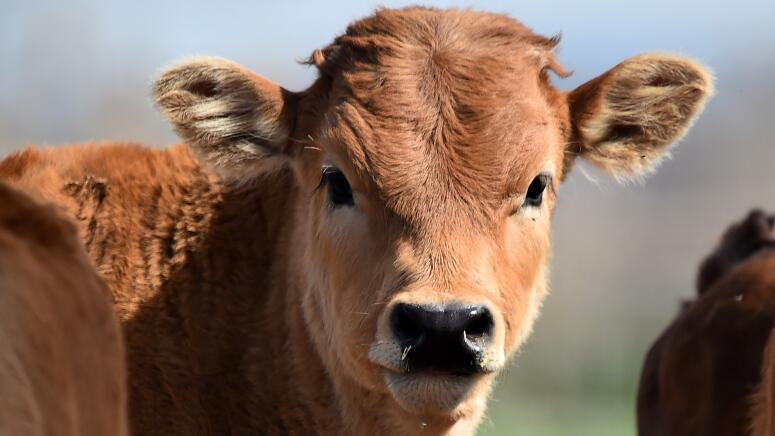
A bottle calf is more than an orphaned or separated bovine young; it is a nurtured, cherished companion that brings joy and affection into the lives of those who care for it.
The process of raising a bottle calf, while demanding, offers immeasurable emotional rewards and ensures the well-being of these endearing animals, fostering a unique bond that transcends the typical livestock-human relationship. Here are a few tips on how to bottle-feed a calf or baby cow:
How to Bottle Feed a Calf: 5 Tips
1. Feeding Schedule
- Most calves need only need 2–3 bottles a day. You won’t have to worry about middle-of-the-night feedings or early-morning waking; bottle calves eat during the day and sleep at night.
- It is a pretty simple process: Feed a bottle 2–3 times a day. They will need only two bottles a day if they are healthy and the weather is nice. If it’s particularly cold or your calf isn’t gaining weight, three bottles will do.
- Watch for scours (more on that in a minute)
- Provide pasture, water, forage (after weaning is most typical), good-quality hay and a clean environment
- Provide a free-choice calf-starter such as Calf-Manna® by Manna Pro® (if desired)
- Offer a good mineral program
2. Nonmedicated Milk Replacer
- Every farm store within 45 miles carries medicated milk replacer, but nonmedicated can be a little more challenging to find.
- Healthy animals do not need medicated milk replacer. I like to avoid the use of unnecessary medications and antibiotics.
- Using medicated products for healthy animals can contribute to the development of antibiotic-resistant bacteria. Additionally, just as they do in people, antibiotics remove good bacteria from the gut.
- When a healthy animal is given un-needed antibiotics, it can cause imbalances and problems. It can even make a well animal sick.
In order to keep our society and animals healthier, be sure to consider a nonmedicated milk replacer such as NurseAll® from Manna Pro
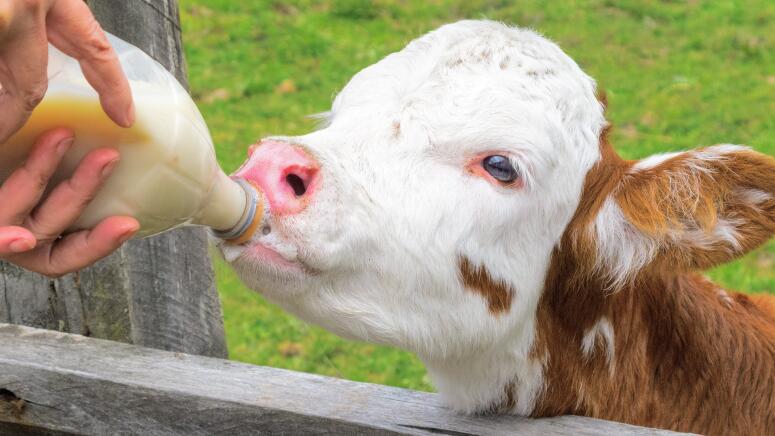
3. Scours
- I’m pretty sure our bottle calves would literally eat themselves to death if given the opportunity. This voracious appetite of theirs can result in what are known as calf scours, or scouring. Calf scours are basically baby cow diarrhea.
- This condition is dangerous and can be fatal. Be sure to watch your bottle calves closely (especially their stool) to be sure everyone is healthy.
- If your bottle calf has access to a lactating dairy cow, they could face a higher probability of overfeeding. Some mama cows will be happy to “adopt” your new calf.
- Even when our calves are being well fed (three bottles a day), they may still run to the milk cows in search of a free meal. Don’t count on a full belly to tell your little one to stop eating.
- If you suspect calf scouring in your herd, contact your veterinarian. Scours can be dangerous for calves (especially very young ones) and need to be treated.
4. Fences are Friends
- If you have ever watched a calf nurse from a mama cow, you probably saw them banging their head into her udder. This is normal behavior that stimulates the udder to “let down” additional milk for the hungry calf.
- This head-butting doesn’t hurt the mama cow, but during bottle feeding it can be annoying.
Calves don’t seem to realize that head-butting the bottle will not make the milk come out any faster, nor will it make any more milk appear. - You may find it helpful to position yourself on the other side of a gate or fence while feeding, which can help minimize head-butting.
5. When the Bottle is Empty, Make Your Exit—Quickly
- When the bottle is empty and feeding time is over, give your little guy (or gal) a scratch, pat them and tell them they’re adorable, and then make your escape—fast. Especially if you did not listen to tip #4 and are standing in the field with them.
- Why? Feeding my little bottle calves can be the highlight of my day. They are so excited. They greet me with the sweetest “moooo” you’ve ever heard. They love their bottles and have the enthusiasm of a puppy. Calves may be the cutest animals in the world
- Unless it’s raining, pouring, sleeting or icing outside. Then it’s not as fun. The calves are just as adorable, grateful and spunky, but I am not as enthusiastic about the whole thing.
- This is why you may need to run after feeding them their bottle.
As soon as our calves finish their bottles, they immediately start looking for an udder. If a lactating dairy animal isn’t in plain sight, the calves may turn to the person holding the bottle—nudging, bumping, and smearing their soaking wet, milky, slobbery heads all over the front and back of my jeans trying to find an udder. - Bang. Nudge. Bump. “There’s got to be one here somewhere.” “No, Norman” (that’s the calf), “I don’t have an udder.”
Raising bottle babies is a fun adventure. If you have always wanted to get into the cattle business but get indigestion when you see cattle prices, a bottle calf may just fit the bill. It’s probably one of the easiest, most inexpensive ways to get into the cattle business. Raising bottle calves will not only get you a herd “on the cheap,” but you’ll also make some great memories.
If you’re worried about all those bottles you’ll have to make, don’t let that stop you. Before you know it, they’ll be all grown up eating pasture and hay and you’ll be looking for a new baby. The next time you find yourself at a sale barn, animal auction, or friend’s house and there’s a calf that needs a good home, consider saying, “Yes!” Raising calves is fun, rewarding and simple.
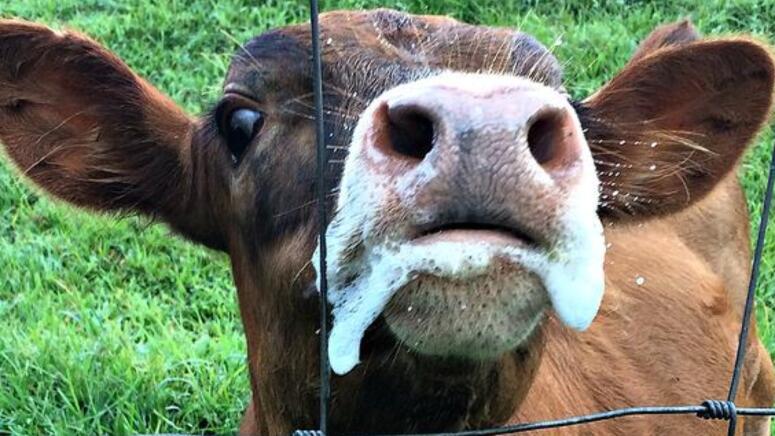
Weaning Your Bottle Calf
Weaning your bottle calf is a big step in its growth journey. Think of it like moving from baby food to more grown-up meals. It's an exciting time, but it's important to do it right to keep your calf happy and healthy.
How old should a bottle calf be to wean?
Usually, calves are ready to start weaning between 8 to 10 weeks old. But it's not just about age; your calf should also be big and strong enough.
Look for these signs: - Your calf is eating solid food like hay and calf starter feed well. - It's lively and active, showing it's in good health. - It's gaining weight steadily, looking more like a little cow and less like a baby.
How to Wean Your Bottle Calf:
- Start with Solid Foods: Before completely stopping the milk replacer, make sure your calf likes eating solid foods. This includes things like hay, grains, and special calf starter feed. Think of these like the calf version of kid's snacks that are tasty but also full of good stuff to help them grow.
- Reduce Milk Slowly: Don't just stop the milk replacer all at once. Start by cutting back a little. For example, if you're giving three bottles a day, go down to two for a week, then one, before stopping entirely. This gives your calf time to adjust.
- Keep an Eye on Health: As you reduce the milk, watch your calf closely. Make sure it's still active and eating its solid food well. If it seems upset or isn't eating, it might not be ready to drop another bottle.
- Patience is Key: Every calf is different. Some might take to weaning quickly, while others need a bit more time. Be patient and watch for those signs that your calf is ready to move on from milk replacer to just solid foods.
Remember, weaning is a big change for your calf, so take it slow and make sure it's ready. With care and attention, you can help your calf make the switch from milk to solid foods just fine!
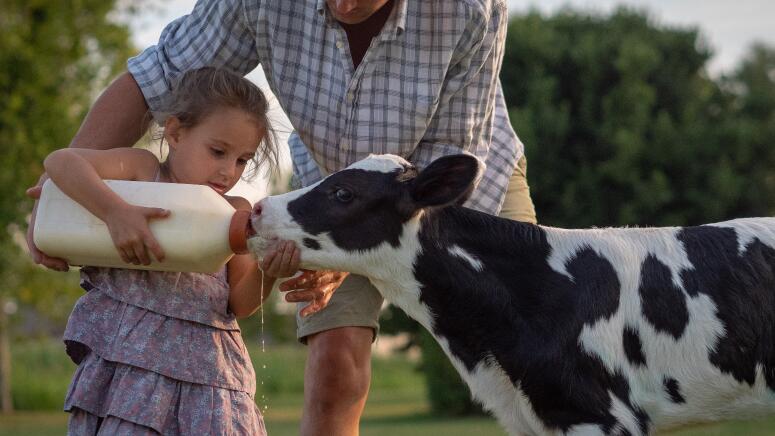
Challenges and Solutions
What happens when I give a bottle calf more than it needs?
Feeding a bottle calf is a lot like making sure a baby eats just the right amount. Giving them too much can lead to tummy troubles. When a bottle calf gets more milk replacer than it needs, it might face issues like scours, which is a fancy word for diarrhea. This isn't just uncomfortable for the calf; it can lead to more serious health problems if not taken care of.
How to Avoid Overfeeding:
- Stick to a Schedule: Just like kids, calves do well with a routine. Feed them at the same times each day to help keep their digestion on track.
- Measure Carefully: Make sure to use the right amount of milk replacer. The instructions on the bag are there to help you give just what your calf needs, no more, no less.
- Watch for Signs: Keep an eye on your calf. If it's looking for more after feeding time, it might not be hungry but just missing the comfort of sucking. Try a pacifier designed for calves to help with this.
Dealing with Scours
If your calf does end up with scours, it's important to act fast.
- Keep Them Hydrated: Scours can make a calf lose a lot of water, so it's crucial to make sure they're drinking plenty. Electrolyte solutions can help keep them hydrated.
- Ease Up on Milk: When a calf has scours, sometimes it helps to cut back on the milk replacer for a bit and offer more electrolytes instead. But, don't stop milk completely without talking to a vet.
- Stay Clean: Keeping your calf and its living area clean helps prevent scours from getting worse or coming back. Make sure their bedding is dry and clean out any dirty spots regularly.
By keeping an eye on how much your calf eats and watching for any signs of tummy trouble, you can help keep them happy, healthy, and growing strong. And remember, if you're ever unsure, it's always a good idea to ask a vet for advice.
After Bottle Feeding
Once your bottle calves are big enough and don't need their bottle anymore, it's like they've graduated from calf kindergarten! It's a big step for them, and there's a whole new world to explore. Here's what comes next:
Joining the Herd:
- Meeting New Friends: After weaning, your calves are ready to hang out with the bigger cows. It's like going to a new school. At first, they might feel a bit shy or nervous, but soon they'll start making friends and fitting in.
- Learning the Ropes: Just like kids learn from each other, calves learn from older cows. They'll pick up on how to graze, find the best spots for water, and even where to rest when they're tired.
Living in the Pasture:
- Taste of Freedom: Moving to the pasture is exciting for calves. They have lots of space to run, play, and eat fresh grass. It's like having a huge playground to explore every day!
- Keep an Eye Out: Even though they're growing up, these former bottle calves still need you to look out for them. Make sure they're eating well, staying healthy, and getting along with the rest of the herd.
Taking Care as They Grow:
- Regular Check-Ups: Just like you visit the doctor, your calves need check-ups too. This helps catch any problems early, so they stay healthy and happy.
- Nutrition is Key: Keep an eye on what they're eating to make sure they're getting all the nutrients they need to grow strong. Sometimes, they might need extra vitamins or minerals.
As your bottle calves grow up, they'll become a regular part of the herd, but they'll always be special because of the extra care you gave them early on. Watching them grow from tiny calves into strong, healthy cows or bulls is super rewarding, and it's all thanks to the great start you gave them!
In Review: Bottle Calf Basics
- Cherished Beginnings: Bottle calves, with their endearing nature, are often likened to family pets due to their affectionate and friendly personalities, stemming from their hand-raised upbringing and close human interaction.
- A Bond Like No Other: The hands-on care involved in raising bottle calves fosters a unique and deep emotional connection, offering a sense of fulfillment and joy to their caregivers.
- Healthy Growth, Happy Calves: Bottle feeding ensures controlled nutrition, allowing for a tailored diet that supports optimal health and development, while also facilitating early detection of potential health issues.
- Social Butterflies of the Barnyard: Thanks to their upbringing, bottle calves often exhibit enhanced social skills, making them less stressed and more harmonious members of the herd as they grow.
- A Call to Care: Encountering an orphan calf presents a rewarding opportunity, not just to start or expand a herd, but to form lifelong bonds and memories with these lovable animals.
- Feeding Fundamentals: A consistent feeding schedule, proper milk replacer measurement, and attentiveness to the calf's behavior are key to avoiding overfeeding and its complications, such as scours.
- Weaning with Wisdom: Transitioning from milk to solid foods is a significant milestone in a calf's life, requiring patience, observation, and gradual reduction of milk intake to ensure a smooth adjustment.
-
Life Beyond the Bottle: Post-weaning, integrating calves into the herd and transitioning them to pasture life marks the beginning of their journey as thriving members of the farm, with continued care and monitoring essential for their long-term well-being.
Bottle Calf FAQs
When to stop bottle feeding a calf?
Bottle feeding should be gradually reduced and eventually stopped as the calf transitions to solid food, typically around 8 to 10 weeks of age. The exact timing can depend on the calf's development, health, and readiness to consume solid feed effectively.
How long does a bottle calf need milk replacer?
A bottle calf typically requires milk replacer until it is ready to be weaned off, which is usually by the age of 8 to 10 weeks. During this period, the calf should also be introduced to and gradually begin consuming solid feeds like calf starter and hay.
How old should a bottle calf be to wean?
The weaning process for a bottle calf can start when the calf is between 8 to 10 weeks old. It's important to ensure the calf is consuming adequate solid food and showing signs of physical readiness and health before fully weaning off milk replacer.
What happens when I give a bottle calf more than it needs?
Overfeeding a bottle calf can lead to digestive issues, most commonly scours (diarrhea), which can be detrimental to the calf's health. It's crucial to adhere to recommended feeding guidelines and closely monitor the calf's intake and health to prevent overfeeding.
Author Profile: Candice Johns
Candi has spent many years growing and striving toward a more self-sufficient life. She grows vegetables, kills chickens, swims with pigs, milks a cow, and loves anything homesteading. She lives out in the country with her husband and 4 awesome children. She likes doing things the old fashioned way.
More Blogs from Candice:
- https://www.mannapro.com/homestead/raising-pigs-for-meat
- https://www.mannapro.com/homestead/how-to-raise-baby-chicks-3-easy-steps
Feature Products

